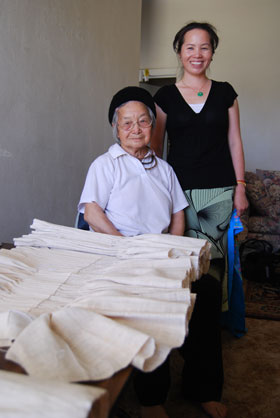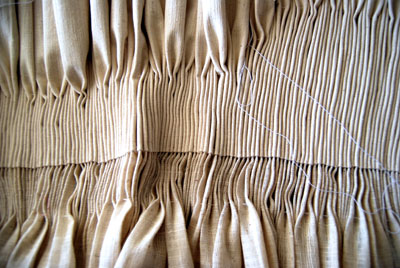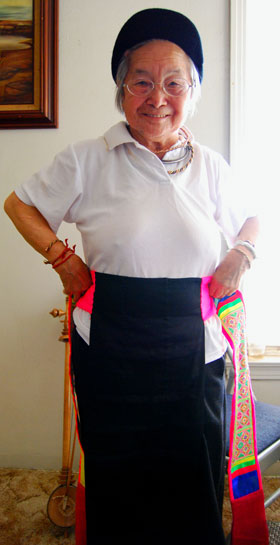Ju Yang
White Hmong tiab dawb
 The tiab dawb is a hand-pleated skirt made of many yards of white hemp fabric, hand-scored, pleated and sewn. An essential part of the traditional White Hmong woman’s ceremonial outfit, the tiab dawb’s pleats are set by tightly wrapping and twisting the skirt in a process which can take several months to a year to complete. In addition to being worn at key times and events in the year, tiab dawb are valued as funeral clothing, and hemp is a preferred fabric for tiab dawb because it decomposes with the body, allowing it to travel with the spirit of the deceased so that one does not arrive to the spirit world unclothed.
The tiab dawb is a hand-pleated skirt made of many yards of white hemp fabric, hand-scored, pleated and sewn. An essential part of the traditional White Hmong woman’s ceremonial outfit, the tiab dawb’s pleats are set by tightly wrapping and twisting the skirt in a process which can take several months to a year to complete. In addition to being worn at key times and events in the year, tiab dawb are valued as funeral clothing, and hemp is a preferred fabric for tiab dawb because it decomposes with the body, allowing it to travel with the spirit of the deceased so that one does not arrive to the spirit world unclothed.
Ju Yang learned textile arts from the age of 8, and has used her skills for over seven decades. Tiab dawb are traditionally made from hemp fabric, which Ju learned to make on a back-strap loom from her aunt and mother when she was a girl in Laos. “In those days, there was no school. So when I started, I worked day and night for it. I even worked with my hands to strip the hemp plant into thread while walking to and from the fields where we worked. If I could finish making the threads with my hands while walking, I would weave on my loom at night before bedtime. When I got married, my husband made me a beautiful loom. I grew my own hemp and every year made new clothes for my family.”
On the importance of the tiab dawb to the White Hmong community, Ju elaborates: “When a person dies, wearing the collection of very finely made traditional clothes they have collected during their lives has so much meaning spiritually and culturally. When a person gets married, the parents give the bride and groom clothes for their future funeral because we believe that the families will recognize each other in the spirit world by the clothes they have made themselves. It is a very important symbol that helps unite our different clans at marriage.”
In 2008, Ju Yang was a master artist in ACTA’s Apprenticeship Program with her apprentice and daughter-in-law Pao Ge Vue. The apprenticeship focused on teaching Pao Ge the skills necessary to complete her first tiab dawb.



